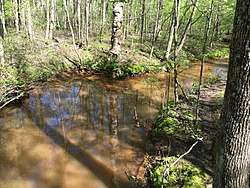Shark River (New Jersey)
| Shark River | |
|---|---|
 As it appears within Shark River Park | |
| Country | United States |
| Physical characteristics | |
| Main source | Eastern Monmouth County |
| River mouth |
Atlantic Ocean 0 m (0 ft) |
| Length | 11.7 miles (18.8 km) |
The Shark River is a river in eastern New Jersey that rises in eastern Monmouth County and flows southeast for 11.7 miles (18.8 km),[1] continuing through Neptune Township and Wall Township. The river continues towards the Shark River Inlet, an estuary that feeds into the Atlantic Ocean between Belmar and Avon-by-the-Sea.
History
Originally called the Nolletquesset River by the Lenni Lenape Indians, the name Shirk River appears on a 1764 indenture for an adjacent land sale. It is said the name refers to the laziness of certain settlers or soldiers who shirked their duties to enjoy the beauty and recreation of the river. The name Shack River is listed on a 1781 map, probably for the many fishing and hunting shanties that lined the shores. Another map of the same time refers to the river as Hogs Pond. By the early 1800s, the crescent-shaped waterway was referred to as Shark River Pond. While it may very well be a derivation of the names "Shirk" or "Shack" River, the evolution of the name is fancifully bantered about in different folk myths. It is said in the mid-1800s, a large shark was swept up river and perished. The locals pulled the creature up on the beach and immortalized it by renaming the river. Others say it is named for the many fossil shark teeth that can still be found along its banks.[2]
One 1812 map of New Jersey has Shark River titled as "White Creek".[3]
River or bay
There is some disagreement about the Shark River actually being a river, as it closely resembles a tidal basin: a tidal, salt water region separated from the open sea by a land formation, or barrier, and primarily influenced by oceanic tidal fluctuations.
The area commonly referred to as the Shark River (not the inlet with its bulkhead) is actually a small bay of approximately eight hundred acres which includes the confluence of four fresh water streams, adjacent mud flats, salt marshes, the open water, and the inlet which connects the bay to the Atlantic Ocean.
The term river generally refers to an aquatic entity that sustains a substantial amount of moving fresh water. The primary tributaries supplying fresh water to the Shark River tidal basin are; Shark River Stream, Jumping Brook; Musquash Brook, and Laurel Brook. These four streams, while draining a sizable watershed, only provide a negligible amount of fresh water to the basin when compared to the large amounts of salt water entering via the normal tidal fluctuation. This small amount of fresh water entering the bay, the relatively small size of the bay itself, and the substantial amounts of salt water that enters the bay (via the inlet), better describes the Shark River as a "tidal basin" than a river.[4]
The river (or stream) travels through sediments deposited during the Late Eocene and Middle Miocene periods. Fossils of reptiles, mammals and shark teeth and other fish remains can be found along its banks.
Monmouth County Park – Shark River Park
Shark River Park, the Monmouth County Park System's first park, opened in 1961, covers 933 acres (3.8 km2) on either side of the Shark River in Neptune and Wall townships.
See also
References
- ↑ U.S. Geological Survey. National Hydrography Dataset high-resolution flowline data. The National Map, accessed April 1, 2011
- ↑ "How did Shark River get its name?". Living in The Hills -- Shark River that is. 2008-03-19. Retrieved 2017-09-10.
- ↑ (http://www.klokantech.com/), Klokan Technologies GmbH. "New Jersey, 1812". davidrumsey.georeferencer.com. Retrieved 2017-09-10.
- ↑ Belmar Website, Residents > Municipal Boards > Environmental Commission > Natural Resources, Zone 5, http://www.belmar.com/Default.asp?Section_ID=623
External links
- AllRefer.com: Shark River, New Jersey
- Shark River Identification Page
- USGS Stream Flow Conditions of the Shark River at Belmar, NJ
Coordinates: 40°10′31″N 74°01′52″W / 40.175266°N 74.031114°W